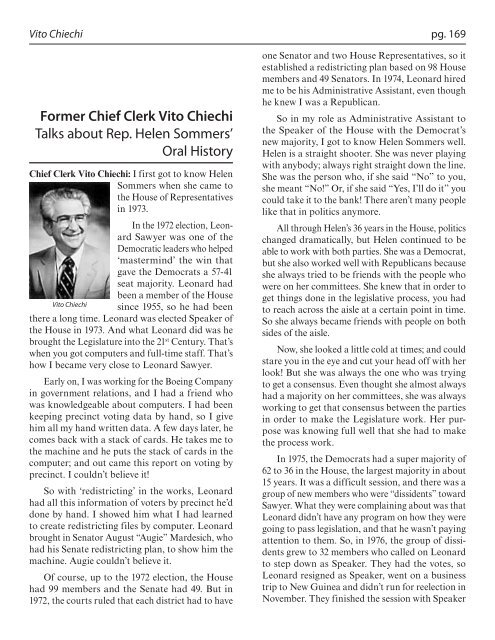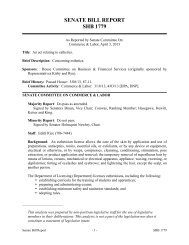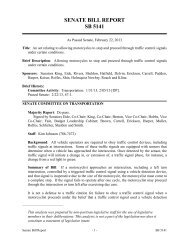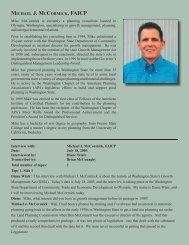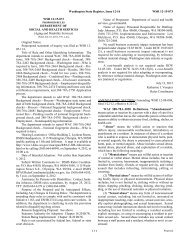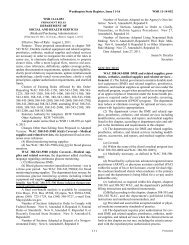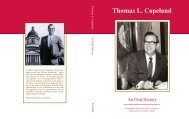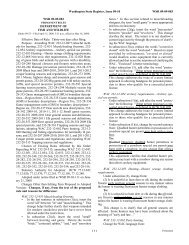Helen Sommers: An Oral History
Helen Sommers: An Oral History
Helen Sommers: An Oral History
You also want an ePaper? Increase the reach of your titles
YUMPU automatically turns print PDFs into web optimized ePapers that Google loves.
Vito Chiechi<br />
Former Chief Clerk vito Chiechi<br />
Talks about Rep. <strong>Helen</strong> <strong>Sommers</strong>’<br />
<strong>Oral</strong> <strong>History</strong><br />
Chief Clerk Vito Chiechi: I first got to know <strong>Helen</strong><br />
<strong>Sommers</strong> when she came to<br />
the House of Representatives<br />
in 1973.<br />
In the 1972 election, Leonard<br />
Sawyer was one of the<br />
Democratic leaders who helped<br />
‘mastermind’ the win that<br />
gave the Democrats a 57-41<br />
seat majority. Leonard had<br />
been a member of the House<br />
since 1955, so he had been<br />
there a long time. Leonard was elected Speaker of<br />
the House in 1973. <strong>An</strong>d what Leonard did was he<br />
brought the Legislature into the 21st Vito Chiechi<br />
Century. That’s<br />
when you got computers and full-time staff. That’s<br />
how I became very close to Leonard Sawyer.<br />
Early on, I was working for the Boeing Company<br />
in government relations, and I had a friend who<br />
was knowledgeable about computers. I had been<br />
keeping precinct voting data by hand, so I give<br />
him all my hand written data. A few days later, he<br />
comes back with a stack of cards. He takes me to<br />
the machine and he puts the stack of cards in the<br />
computer; and out came this report on voting by<br />
precinct. I couldn’t believe it!<br />
So with ‘redistricting’ in the works, Leonard<br />
had all this information of voters by precinct he’d<br />
done by hand. I showed him what I had learned<br />
to create redistricting files by computer. Leonard<br />
brought in Senator August “Augie” Mardesich, who<br />
had his Senate redistricting plan, to show him the<br />
machine. Augie couldn’t believe it.<br />
Of course, up to the 1972 election, the House<br />
had 99 members and the Senate had 49. But in<br />
1972, the courts ruled that each district had to have<br />
pg. 169<br />
one Senator and two House Representatives, so it<br />
established a redistricting plan based on 98 House<br />
members and 49 Senators. In 1974, Leonard hired<br />
me to be his Administrative Assistant, even though<br />
he knew I was a Republican.<br />
So in my role as Administrative Assistant to<br />
the Speaker of the House with the Democrat’s<br />
new majority, I got to know <strong>Helen</strong> <strong>Sommers</strong> well.<br />
<strong>Helen</strong> is a straight shooter. She was never playing<br />
with anybody; always right straight down the line.<br />
She was the person who, if she said “No” to you,<br />
she meant “No!” Or, if she said “Yes, I’ll do it” you<br />
could take it to the bank! There aren’t many people<br />
like that in politics anymore.<br />
All through <strong>Helen</strong>’s 36 years in the House, politics<br />
changed dramatically, but <strong>Helen</strong> continued to be<br />
able to work with both parties. She was a Democrat,<br />
but she also worked well with Republicans because<br />
she always tried to be friends with the people who<br />
were on her committees. She knew that in order to<br />
get things done in the legislative process, you had<br />
to reach across the aisle at a certain point in time.<br />
So she always became friends with people on both<br />
sides of the aisle.<br />
Now, she looked a little cold at times; and could<br />
stare you in the eye and cut your head off with her<br />
look! But she was always the one who was trying<br />
to get a consensus. Even thought she almost always<br />
had a majority on her committees, she was always<br />
working to get that consensus between the parties<br />
in order to make the Legislature work. Her purpose<br />
was knowing full well that she had to make<br />
the process work.<br />
In 1975, the Democrats had a super majority of<br />
62 to 36 in the House, the largest majority in about<br />
15 years. It was a difficult session, and there was a<br />
group of new members who were “dissidents” toward<br />
Sawyer. What they were complaining about was that<br />
Leonard didn’t have any program on how they were<br />
going to pass legislation, and that he wasn’t paying<br />
attention to them. So, in 1976, the group of dissidents<br />
grew to 32 members who called on Leonard<br />
to step down as Speaker. They had the votes, so<br />
Leonard resigned as Speaker, went on a business<br />
trip to New Guinea and didn’t run for reelection in<br />
November. They finished the session with Speaker


